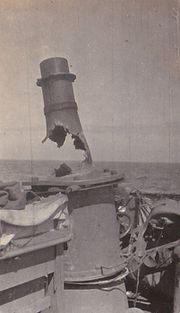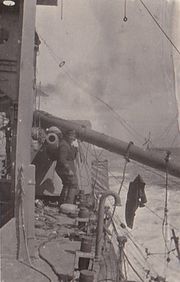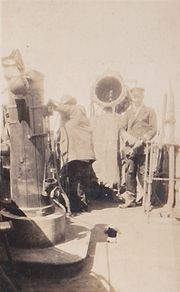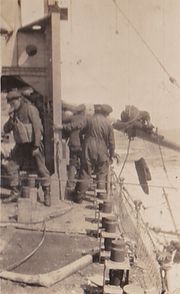H.M.S. Broke (1914)
| H.M.S. Broke (1914) | |
|---|---|
| Pendant Number: | H.98 (1914) H.23 (Jan 1918) D.10 (Sep 1918)[1] |
| Builder: | J. Samuel White[2] |
| Launched: | 25 May, 1914[3] |
| To Chile: | May, 1920[4] |
H.M.S. Broke was one of four Faulknor class flotilla leaders. Returned to Chile in 1920, there would be another leader H.M.S. Broke commissioned in the 1920s.
Service
| H.M.S. Broke after Battle of Jutland | |||
 |
 |
 |

|
| Destroyed Rangefinder | Mast Overboard | Fore Bridge | Upper Deck |
In September 1914, it was decided that Broke should join the Second Destroyer Flotilla as the half-flotilla leader and be fitted with a Mark II W/T set, longer mast, No. 2 set of flags and two additional signal ratings.[5]
On 17 December, 1914, Broke and the scout cruiser Bellona collided; Roper "[i]ncurred TL displeasure" in the incident. Roper was also blamed for damaging jetties and tugs at Leith when he backed his ship out of a dock in March, 1915.[6]
At the Battle of Jutland, she was the second in command of the Fourth Destroyer Flotilla, leading the second half-flotilla.[7] Broke collided with Sparrowhawk after attempting to fire her second torpedo at a cruiser. In the end, Broke suffered 42 men killed, 6 missing, 14 severely wounded and 20 slightly wounded and wound up with twenty-three of Sparrowhawk's men on her foredeck, some having jumped there in the belief that Broke was the more viable ship and others having fallen there in the collision.
Just after midnight on the night of 20-21 April, 1917, Broke and Swift intercepted six German destroyers returning from a bombardment of Dover, sparking a brief and intense night action, the Second Battle of Dover Strait. The British attempted to ram the onrushing enemy. Swift missed, but Broke connected with Template:DE-G42 as she fired on the German destroyer. A German torpedo found her, however, though she remained afloat with help from Swift.[8]
Broke was reduced to a C. & M. Party at Portsmouth on 17 October, 1919.[9]
Captains
Dates of appointment are provided when known.
- Commander Charles D. Roper, 9 October, 1914[10][11] – 25 July, 1915[12]
- Commander Harold E. Sulivan, 25 July, 1915[13] – 21 August, 1915[14]
- Commander Walter L. Allen, 21 August, 1915[15][16] – 10 June, 1916[17] (in command at Battle of Jutland)
- Captain Edward O. Gladstone, 30 June, 1916[18][19] – November, 1916[20] (and as Captain (D), Eleventh Destroyer Flotilla)
- Commander Edward R. G. R. Evans, December, 1916[21] – 25 October, 1917[22] (in command during Second Battle of Dover Strait)
- Commander Bertram H. Ramsay, 25 October, 1917[23] – 15 January, 1919
- Commander Henry G. L. Oliphant, 17 January, 1919[24] – 17 March, 1919[25]
- Commander Geoffrey Corlett, 1 May, 1919[26][27] – 17 October, 1919[28] (and for charge of a group of T.B.Ds.)
Armament
4-in and 6-in Guns
Torpedoes
21-in torpedoes
The ship was equipped with Service single revolving tubes and used side-lug torpedoes. At outbreak of war, one 21-in Weymouth Mark III* (then being tested) and six Weymouth Mark II (then being intended for Japanese purchase) were given to Broke. The Mark II torpedoes had settings for 38 knots to 3,500 metres and 25 knots to 10,000 metres.[29]
See Also
Footnotes
- ↑ Dittmar; Colledge. British Warships 1914–1919. p. 65.
- ↑ Conway's All the World's Fighting Ships 1906–1921. p. 78.
- ↑ Conway's All the World's Fighting Ships 1906–1921. p. 78.
- ↑ Dittmar; Colledge. British Warships 1914–1919. p. 65.
- ↑ Grand Fleet Conferences, 1914. p. 104.
- ↑ Roper Service Record. The National Archives. ADM 196/44/151. f. 169.
- ↑ Battle of Jutland Official Despatches. p. 34.
- ↑ Smith. Hard Lying. pp. 104-5.
- ↑ The Navy List. (June, 1920). p. 736.
- ↑ Roper Service Record. The National Archives. ADM 196/44/151. f. 169.
- ↑ The Navy List. (April, 1915). p. 392n.
- ↑ Roper Service Record. The National Archives. ADM 196/44/151. f. 169.
- ↑ Sulivan Service Record. The National Archives. ADM 196/44/250. f. 283.
- ↑ Sulivan Service Record. The National Archives. ADM 196/44/250. f. 283.
- ↑ The Navy List. (October, 1915). p. 392n.
- ↑ Allen Service Record. The National Archives. ADM 196/44. f. 280.
- ↑ Allen Service Record. The National Archives. ADM 196/44. f. 280.
- ↑ Gladstone Service Record. The National Archives. ADM 196/44/129. f. 144.
- ↑ The Navy List. (December, 1916). p. 392q.
- ↑ Gladstone Service Record. The National Archives. ADM 196/44/129. f. 144.
- ↑ The Navy List. (November, 1917). p. 391y.
- ↑ Month name given as "X" in Evans Service Record. The National Archives. ADM 196/46. f. 40.
- ↑ The Navy List. (January, 1919). p. 746.
- ↑ Oliphant Service Record. The National Archives. ADM 196/45/83. f. 83.
- ↑ Oliphant Service Record. The National Archives. ADM 196/45/83. f. 83.
- ↑ Corlett Service Record. The National Archives. ADM 196/47/47. f. 252.
- ↑ The Navy List. (June, 1919). p. 746.
- ↑ Corlett Service Record. The National Archives. ADM 196/47/47. f. 252.
- ↑ Annual Report of the Torpedo School, 1914. pp. 10-12, 15.
Bibliography
- March, Edgar J. (1966). British Destroyers: A History of Development, 1892-1953. London: Seeley Service & Co. Limited. (on Bookfinder.com).
| Faulknor Class Flotilla Leader | |||||||||||||||||||||||||||||||||||||||||||||||||||||||||||||||||||||||||||||||||||||||||||||||||||||||||||||||||||||||
| Botha | Broke | Faulknor | Tipperary | ||||||||||||||||||||||||||||||||||||||||||||||||||||||||||||||||||||||||||||||||||||||||||||||||||||||||||||||||||||
| <– | H.M.S. Swift | Destroyer Leaders (UK) | Lightfoot Class | –> | |||||||||||||||||||||||||||||||||||||||||||||||||||||||||||||||||||||||||||||||||||||||||||||||||||||||||||||||||||